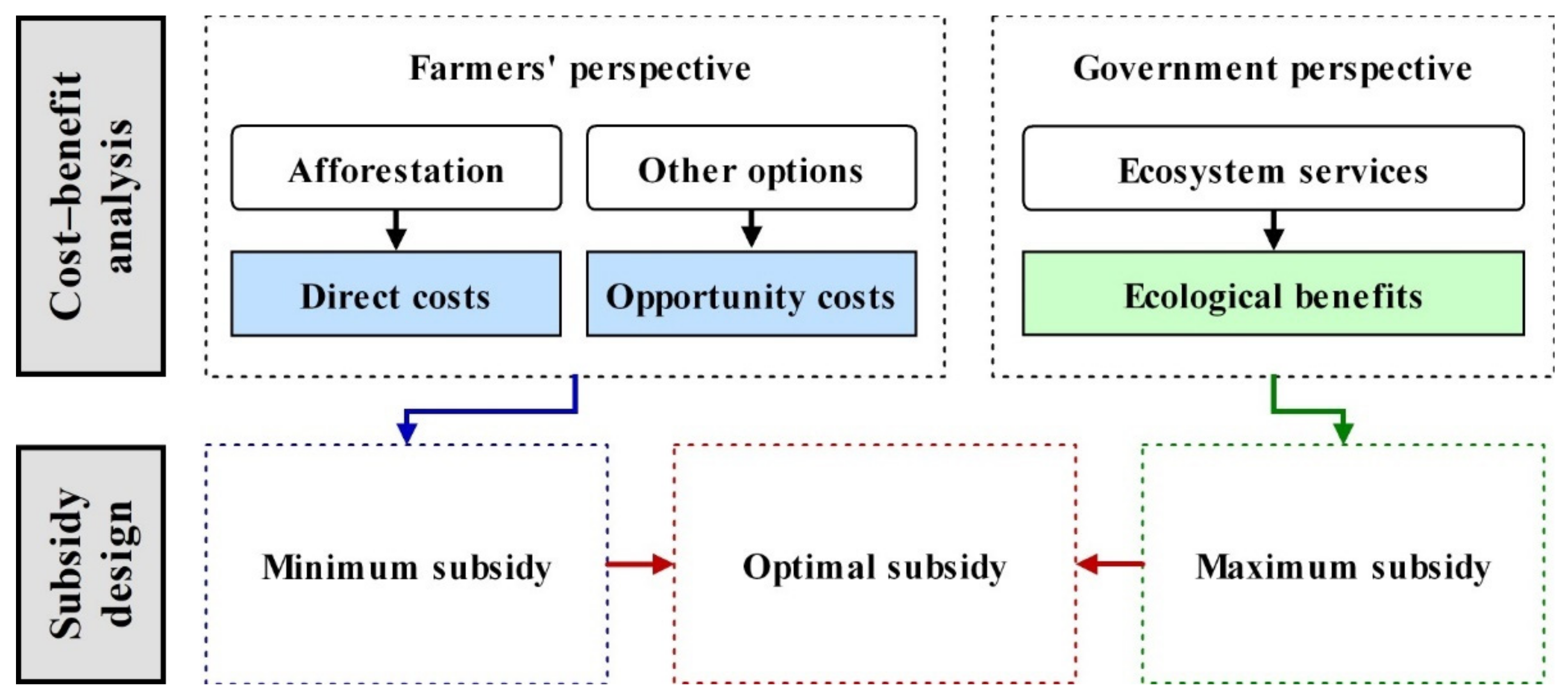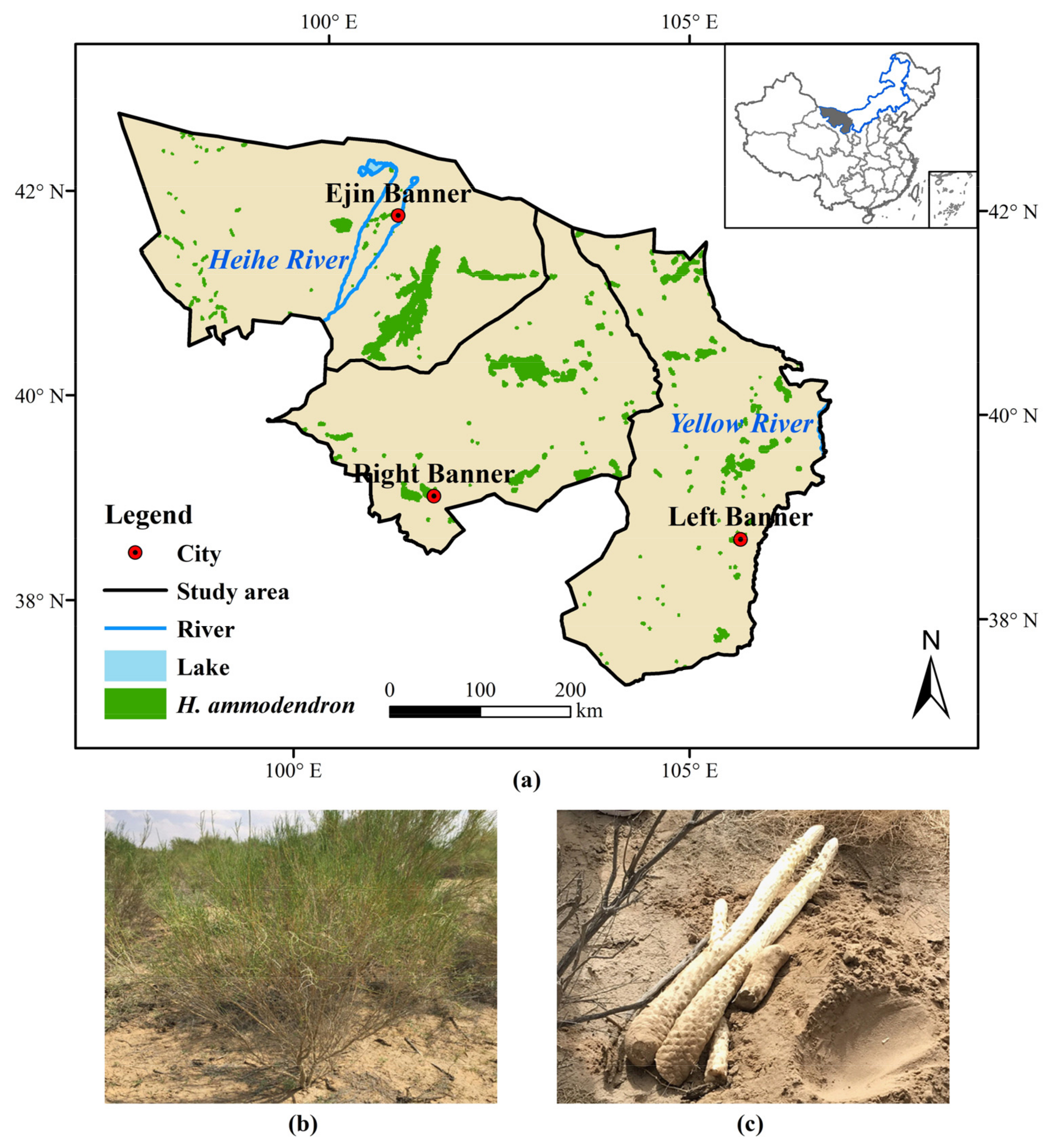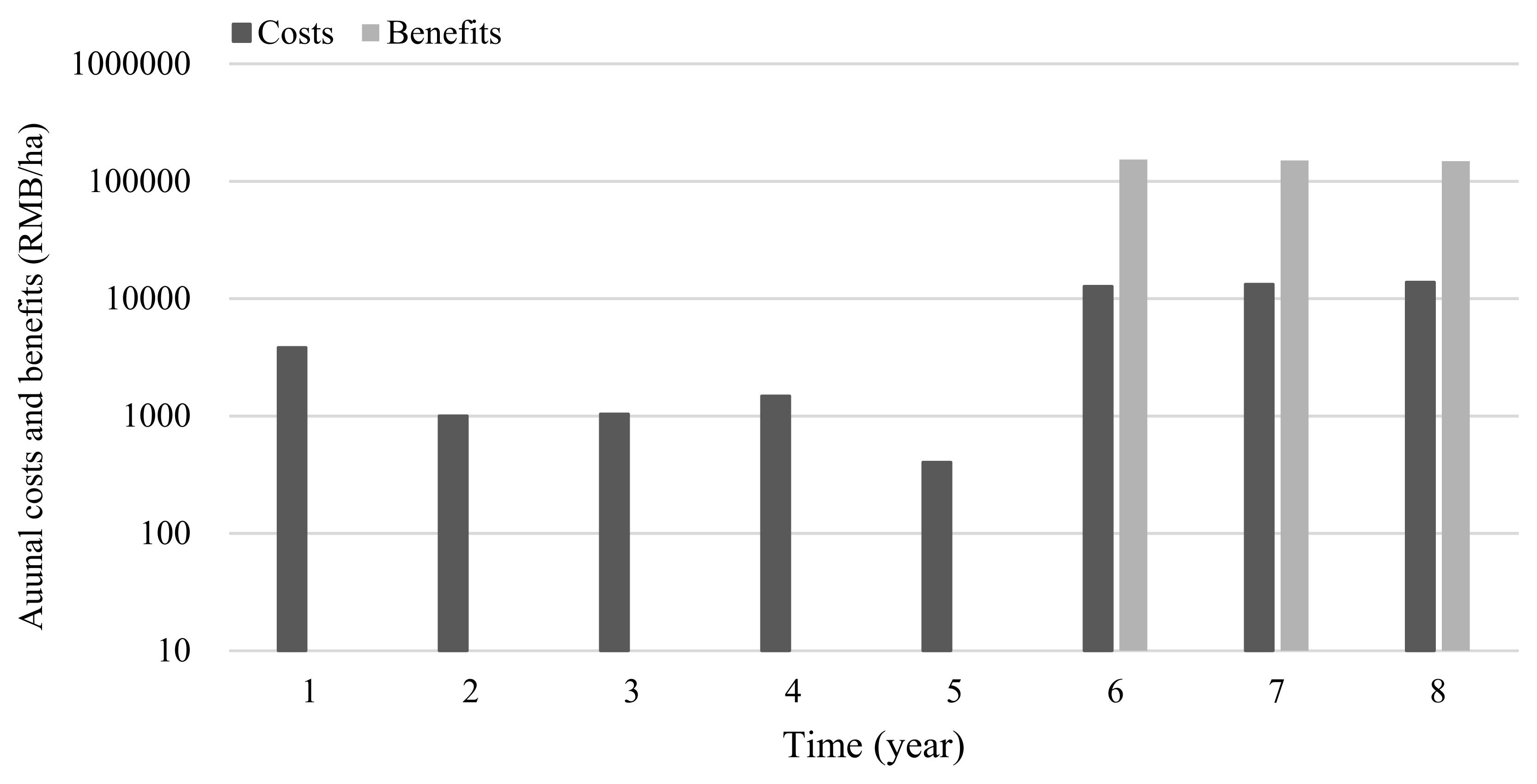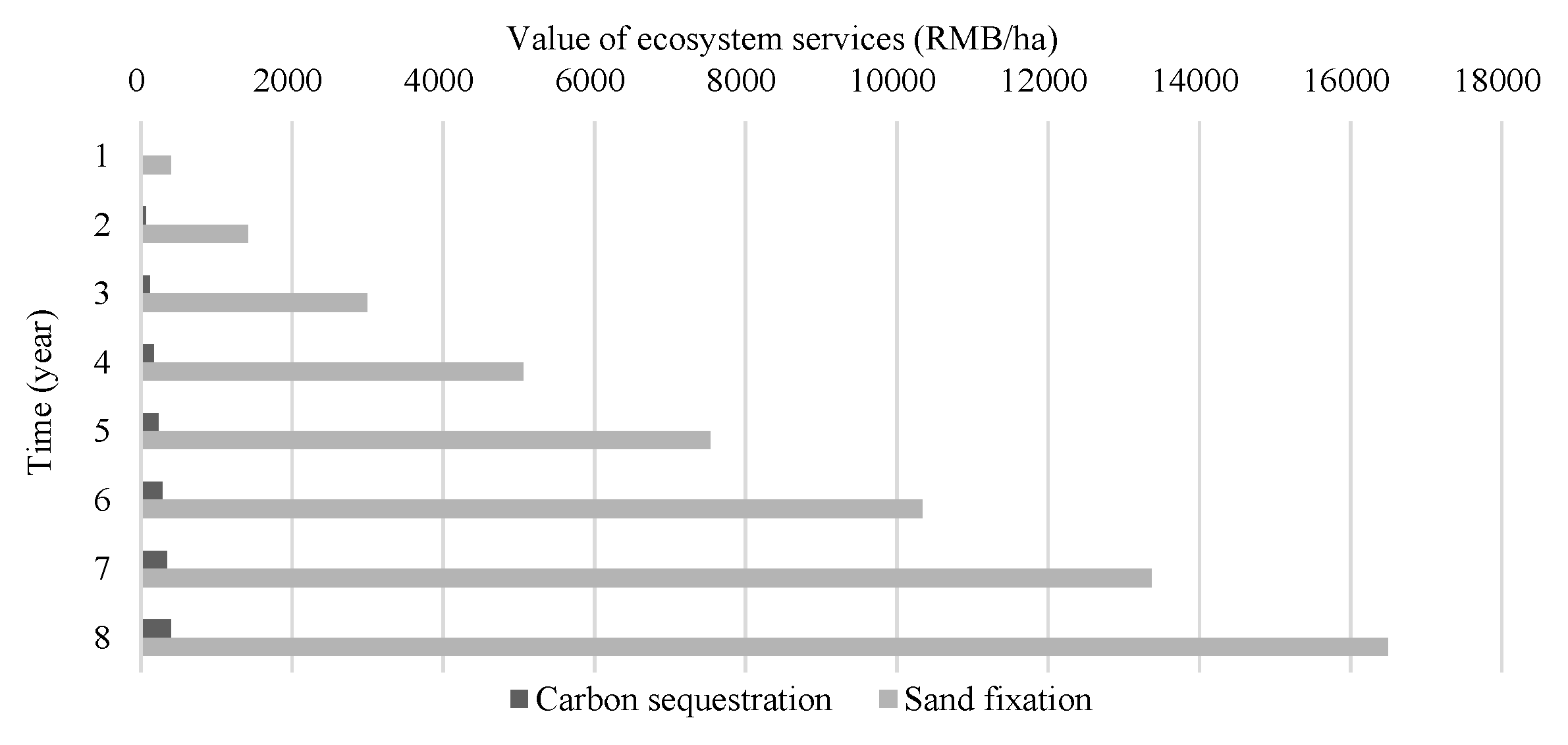Afforestation Subsidy Determination for Haloxylon ammodendron (C.A.Mey.) Bunge in China Based on Cost–Benefit Analysis
Abstract
:1. Introduction
2. Research Framework
3. Materials and Methods
3.1. Study Area
3.2. Data Collection and Processing
3.3. Methods
3.3.1. Direct Costs
3.3.2. Opportunity Costs
3.3.3. Ecological Benefits
- 1.
- Sand fixation service
- 2.
- Carbon sequestration service
4. Results
4.1. Lower Limit of Subsidy Based on Farmers’ Direct Costs
4.2. Lower Limit of Subsidy Based on Farmers’ Opportunity Costs
4.3. Upper Limit of Subsidy Based on Government’s Ecological Benefits
4.4. Determination of Afforestation Subsidy from Multiple Perspectives
5. Discussion
6. Conclusions
Author Contributions
Funding
Institutional Review Board Statement
Informed Consent Statement
Data Availability Statement
Conflicts of Interest
References
- Barry, L.E.; Yao, R.T.; Harrison, D.R.; Paragahawewa, U.H.; Pannell, D.J. Enhancing ecosystem services through afforestation: How policy can help. Land Use Policy 2014, 39, 135–145. [Google Scholar] [CrossRef]
- Strange, N.; Jacobsen, J.B.; Thorsen, B.J. Afforestation as a real option with joint production of environmental services. For. Policy Econ. 2019, 104, 146–156. [Google Scholar] [CrossRef]
- Su, K.; Sun, X.; Guo, H.; Long, Q.; Li, S.; Mao, X.; Niu, T.; Yu, Q.; Wang, Y.; Yue, D. The establishment of a cross-regional differentiated ecological compensation scheme based on the benefit areas and benefit levels of sand-stabilization ecosystem service. J. Clean. Prod. 2020, 270, 122490. [Google Scholar] [CrossRef]
- Alix-Garcia, J.; Wolff, H. Payment for Ecosystem Services from Forests. Annu. Rev. Resour. Econ. 2014, 6, 361–380. [Google Scholar] [CrossRef] [Green Version]
- Liagre, L.; Pettenella, D.; Pra, A.; Carazo Ortiz, F.; Garcia Arguedas, A.; Nguyen Chien, C. How can National Forest Funds catalyse the provision of ecosystem services? Lessons learned from Costa Rica, Vietnam, and Morocco. Ecosyst. Serv. 2021, 47, 101228. [Google Scholar] [CrossRef]
- Brouwer, R.; Lienhoop, N.; Oosterhuis, F. Incentivizing afforestation agreements: Institutional-economic conditions and motivational drivers. J. For. Econ. 2015, 21, 205–222. [Google Scholar] [CrossRef]
- Chu, X.; Zhan, J.; Wang, C.; Hameeda, S.; Wang, X. Households’ Willingness to Accept Improved Ecosystem Services and Influencing Factors: Application of Contingent Valuation Method in Bashang Plateau, Hebei Province, China. J. Environ. Manag. 2020, 255, 109925. [Google Scholar] [CrossRef] [PubMed]
- Thorsen, B.J. Afforestation as a Real Option: Some Policy Implications. For. Sci. 1999, 45, 171–178. [Google Scholar] [CrossRef]
- Lawson, G.J.; Dupraz, C.; Herzog, F.; Moreno, G.; Pisanelli, A.; Thomas, T.H. Incentives for Tree Planting on Farms in the European Union—Is Agroforestry Supported? SAFE Project (Silvoarable Agroforestry for Europe) First Year Report WP9 Annex1. 2002. Available online: https://www1.montpellier.inra.fr/safe/english/results/annual_report/SAFE-first-year-report-WP9-annex1.pdf (accessed on 28 January 2022).
- Cao, S.; Xu, C.; Chen, L.; Wang, X. Attitudes of farmers in China’s northern Shaanxi Province towards the land-use changes required under the Grain for Green Project, and implications for the project’s success. Land Use Policy 2009, 26, 1182–1194. [Google Scholar] [CrossRef]
- Yu, J.; Yao, S.; Zhang, B. Designing afforestation subsidies that account for the benefits of carbon sequestration: A case study using data from China’s Loess Plateau. J. For. Econ. 2014, 20, 65–76. [Google Scholar] [CrossRef]
- Mogas, J.; Riera, P.; Bennett, J. Accounting for afforestation externalities: A comparison of contingent valuation and choice modelling. Eur. Environ. 2005, 15, 44–58. [Google Scholar] [CrossRef]
- Sheng, W.; Zhen, L.; Xie, G.; Xiao, Y. Determining eco-compensation standards based on the ecosystem services value of the mountain ecological forests in Beijing, China. Ecosyst. Serv. 2017, 26, 422–430. [Google Scholar] [CrossRef]
- Muradian, R.; Corbera, E.; Pascual, U.; Kosoy, N.; May, P.H. Reconciling theory and practice: An alternative conceptual framework for understanding payments for environmental services. Ecol. Econ. 2010, 69, 1202–1208. [Google Scholar] [CrossRef]
- Börner, J.; Wunder, S.; Wertz-Kanounnikoff, S.; Tito, M.R.; Pereira, L.; Nascimento, N. Direct conservation payments in the Brazilian Amazon: Scope and equity implications. Ecol. Econ. 2010, 69, 1272–1282. [Google Scholar] [CrossRef]
- Chen, X.; Lupi, F.; Viña, A.; He, G.; Liu, J. Using Cost-Effective Targeting to Enhance the Efficiency of Conservation Investments in Payments for Ecosystem Services. Conserv. Biol. 2010, 24, 1469–1478. [Google Scholar] [CrossRef]
- Whiteman, A.; Wickramasinghe, A.; Piña, L. Global trends in forest ownership, public income and expenditure on forestry and forestry employment. For. Ecol. Manag. 2015, 352, 99–108. [Google Scholar] [CrossRef] [Green Version]
- Enters, T.; Durst, P.; Brown, C. What Does It Take? The Role of Incentives in Forest Plantation Development in Asia and the Pacific; Food and Agriculture Organization of the United States: Bangkok, Thailand, 2004. [Google Scholar]
- Parks, P.J.; Hardie, I.W. Least-Cost Forest Carbon Reserves: Cost-Effective Subsidies to Convert Marginal Agricultural Land to Forests. Land Econ. 1995, 71, 122–136. [Google Scholar] [CrossRef]
- De Vreese, R.; Van Herzele, A.; Dendoncker, N.; Fontaine, C.M.; Leys, M. Are stakeholders’ social representations of nature and landscape compatible with the ecosystem service concept? Ecosyst. Serv. 2019, 37, 100911. [Google Scholar] [CrossRef]
- Liu, J.; Li, S.; Ouyang, Z.; Tam, C.; Chen, X. Ecological and socioeconomic effects of China’s policies for ecosystem services. Proc. Natl. Acad. Sci. USA 2008, 105, 9477. [Google Scholar] [CrossRef] [Green Version]
- Źróbek-Różańska, A.; Nowak, A.; Nowak, M.; Źróbek, S. Financial Dilemmas Associated with the Afforestation of Low-Productivity Farmland in Poland. Forests 2014, 5, 2846–2864. [Google Scholar] [CrossRef] [Green Version]
- Duesberg, S.; O’Connor, D.; Dhubháin, Á.N. To plant or not to plant—Irish farmers’ goals and values with regard to afforestation. Land Use Policy 2013, 32, 155–164. [Google Scholar] [CrossRef]
- Jack, B.K.; Jayachandran, S. Self-selection into payments for ecosystem services programs. Proc. Natl. Acad. Sci. USA 2019, 116, 5326. [Google Scholar] [CrossRef] [PubMed] [Green Version]
- Babcock, B.A.; Lakshminarayan, P.G.; Wu, J.; Zilberman, D. Targeting Tools for the Purchase of Environmental Amenities. Land Econ. 1997, 73, 325–339. [Google Scholar] [CrossRef]
- Pagiola, S.; Platais, G. Payments for Environmental Services: From Theory to Practice; World Bank: Washington, DC, USA, 2007. [Google Scholar]
- Engel, S.; Pagiola, S.; Wunder, S. Designing payments for environmental services in theory and practice: An overview of the issues. Ecol. Econ. 2008, 65, 663–674. [Google Scholar] [CrossRef]
- Mao, D.; Wang, Z.; Wu, B.; Zeng, Y.; Luo, L.; Zhang, B. Land degradation and restoration in the arid and semiarid zones of China: Quantified evidence and implications from satellites. Land Degrad. Dev. 2018, 29, 3841–3851. [Google Scholar] [CrossRef]
- Tu, P.F.; Guo, H.Y. Cultivation Techniques of Cistanche Deserticola and Its Host Haloxylon Plants; Science Press: Beijing, China, 2015; pp. 67–101. (In Chinese) [Google Scholar]
- Hao, C.; Duan, N.; Yuan, Y.; Xu, J.; Gao, L.J.; Liu, Y.T. Economic benefit analysis of desert plant Cistanche deserticola. For. Sci. Technol. 2018, 10, 73–75. (In Chinese) [Google Scholar]
- Zheng, X.M.; Li, X.W.; Sun, G.L.; Wang, L.; Wang, H.L. Comparison of benefits of inoculation of Cistanche deserticola in Haloxylon ammodendron with different planting years in desert areas. Jiangsu Agric. Sci. 2019, 47, 143–148. (In Chinese) [Google Scholar]
- Huang, Z.P.; Liu, Z.J.; Cui, W.C. A preliminary study on Haloxylon ammodendron afforestation by water-harvesting. Xinjiang Agric. Sci. 1985, 6, 23–25. (In Chinese) [Google Scholar]
- Li, Y.F. A study on Haloxylon ammodendron planting under two irrigation conditions. Arid. Zone Res. 1992, 4, 38–41. (In Chinese) [Google Scholar]
- Wang, Z.S.; Wang, J.J.; Liu, L. Study on the compensation standard of returning farmland to forest in Xiannangou watershed from the perspective of carbon sink. J. Nat. Resour. 2016, 31, 779–788. (In Chinese) [Google Scholar]
- Wang, Y.; Zhang, Q.; Bilsborrow, R.; Tao, S.; Chen, X.; Sullivan-Wiley, K.; Huang, Q.; Li, J.; Song, C. Effects of payments for ecosystem services programs in China on rural household labor allocation and land use: Identifying complex pathways. Land Use Policy 2020, 99, 105024. [Google Scholar] [CrossRef]
- Liu, H.J.; Yuan, H.B.; Wang, D.Z.; Liu, S.J.; Guo, C.X.; Ma, R.; Li, X.M.; Liu, K.L.; Wang, X.; Li, J.J. Benefits of windbreak and sand fixation from two kinds of shrubs. Bull. Soil Water Conserv. 2017, 37, 63–66. (In Chinese) [Google Scholar]
- Buras, A.; Wucherer, W.; Zerbe, S.; Noviskiy, Z.; Muchitdinov, N.; Shimshikov, B.; Zverev, N.; Schmidt, S.; Wilmking, M.; Thevs, N. Allometric variability of Haloxylon species in Central Asia. For. Ecol. Manag. 2012, 274, 1–9. [Google Scholar] [CrossRef]
- Fryrear, D.W.; Bilbro, J.D.; Saleh, A.; Schomberg, H.; Stout, J.E.; Zobeck, T.M. RWEQ: Improved wind erosion technology. J. Soil Water Conserv. 2000, 55, 183. [Google Scholar]
- Jiang, C.; Li, D.; Wang, D.; Zhang, L. Quantification and assessment of changes in ecosystem service in the Three-River Headwaters Region, China as a result of climate variability and land cover change. Ecol. Indic. 2016, 66, 199–211. [Google Scholar] [CrossRef]
- Tao, Y.; Zhang, Y.M. Multi-scale biomass estimation of desert shrubs: A case study of Haloxylon ammodendron in the Gurbantunggut Desert, China. Acta Agrestia Sin. 2013, 22, 1–10. (In Chinese) [Google Scholar]
- Zhao, C.Y.; Song, Y.D.; Wang, Y.C.; Jiang, P.A. Estimation of aboveground biomass of desert plants. Chin. J. Appl. Ecol. 2004, 15, 49–52. (In Chinese) [Google Scholar]
- Song, Y.Y.; Chu, G.M.; Hu, X.J. Evaluation on age estimation model of Haloxylon ammodendron in the Gurbantongut Desert. J. Arid. Land Resour. Environ. 2011, 25, 166–170. (In Chinese) [Google Scholar]
- Sheng, J.H.; Qiao, Y.X.; Liu, H.Y.; Zhai, Z.X.; Guo, H.Y. A study on the root system of Haloxylon Aammodendron (C. A. Mey.) bunge. Acta Agrestia Sin. 2004, 2, 91–94. (In Chinese) [Google Scholar]
- Zhou, S.; Yin, Y.; Xu, W.; Ji, Z.; Caldwell, I.; Ren, J. The costs and benefits of reforestation in Liping County, Guizhou Province, China. J. Environ. Manag. 2007, 85, 722–735. [Google Scholar] [CrossRef]
- Khan, N.; Shah, S.J.; Rauf, T.; Zada, M.; Yukun, C.; Harbi, J. Socioeconomic Impacts of the Billion Trees Afforestation Program in Khyber Pakhtunkhwa Province (KPK), Pakistan. Forests 2019, 10, 703. [Google Scholar] [CrossRef] [Green Version]
- Wünscher, T.; Engel, S.; Wunder, S. Spatial targeting of payments for environmental services: A tool for boosting conservation benefits. Ecol. Econ. 2008, 65, 822–833. [Google Scholar] [CrossRef]
- Li, T.; Zhang, Q.; Zhang, Y. Modelling a Compensation Standard for a Regional Forest Ecosystem: A Case Study in Yanqing District, Beijing, China. Int. J. Environ. Res. Public Health 2018, 15, 565. [Google Scholar] [CrossRef] [Green Version]
- Feng, L.; Xu, J. Farmers’ Willingness to Participate in the Next-Stage Grain-for-Green Project in the Three Gorges Reservoir Area, China. Environ. Manag. 2015, 56, 505–518. [Google Scholar] [CrossRef] [PubMed]
- Zhang, Z.; Paudel, K.P. Policy improvements and farmers’ willingness to participate: Insights from the new round of China’s Sloping Land Conversion Program. Ecol. Econ. 2019, 162, 121–132. [Google Scholar] [CrossRef]
- Heink, U.; Hauck, J.; Jax, K.; Sukopp, U. Requirements for the selection of ecosystem service indicators—The case of MAES indicators. Ecol. Indic. 2016, 61, 18–26. [Google Scholar] [CrossRef]
- Pagiola, S. Payments for environmental services in Costa Rica. Ecol. Econ. 2008, 65, 712–724. [Google Scholar] [CrossRef] [Green Version]
- Wunder, S.; Brouwer, R.; Engel, S.; Ezzine-de-Blas, D.; Muradian, R.; Pascual, U.; Pinto, R. From principles to practice in paying for nature’s services. Nat. Sustain. 2018, 1, 145–150. [Google Scholar] [CrossRef]
- Gibbons, J.M.; Nicholson, E.; Milner-Gulland, E.J.; Jones, J.P.G. Should payments for biodiversity conservation be based on action or results? J. Appl. Ecol. 2011, 48, 1218–1226. [Google Scholar] [CrossRef]
- Ranjan, R. Payments for ecosystems services-based agroforestry and groundwater nitrate remediation: The case of Poplar deltoides in Uttar Pradesh, India. J. Clean. Prod. 2021, 287, 125059. [Google Scholar] [CrossRef]
- Verhagen, W.; Kukkala, A.S.; Moilanen, A.; van Teeffelen, A.J.A.; Verburg, P.H. Use of demand for and spatial flow of ecosystem services to identify priority areas. Conserv. Biol. 2017, 31, 860–871. [Google Scholar] [CrossRef]
- Liu, M.; Yang, L.; Min, Q. Establishment of an eco-compensation fund based on eco-services consumption. J. Environ. Manag. 2018, 211, 306–312. [Google Scholar] [CrossRef]
- Pei, S.; Zhang, C.; Liu, C.; Liu, X.; Xie, G. Forest ecological compensation standard based on spatial flowing of water services in the upper reaches of Miyun Reservoir, China. Ecosyst. Serv. 2019, 39, 100983. [Google Scholar] [CrossRef]




| Item | Description | Year | Cost (RMB/ha) |
|---|---|---|---|
| Land leveling | 5 ha of land can be leveled in 12 h, 50 RMB/h | 1 | 120 |
| Irrigation | Water consumption 1500 t/ha, 0.1 RMB/t | 150 | |
| Irrigation equipment | Pipes, joints, and pumps | 1800 | |
| H. ammodendron seedlings | 0.1 RMB/seedling | 52.5 | |
| Planting of seedlings | 1 ha of land can be planted in 12 h, 50 RMB/h | 600 | |
| Fertilizer | Nitrogen fertilizer 5.2 g/plant, 2928.7 RMB/t; Potassium fertilizer 77 g/plant, 2257.2 RMB/t | 99 |
| Item | Description | Year | Cost (RMB/ha) |
|---|---|---|---|
| Irrigation | Water consumption 900 t/ha in year 1 and 450 t/ha in year 2–8, 0.1 RMB/t | 1 | 90 |
| 2–8 | 45 | ||
| Weeding | Weeding 3 times per annum in years 1–3 and once per annum in years 4–8, 300 RMB/ha | 1–3 | 900 |
| 4–8 | 300 | ||
| C. deserticola Ma seeds | 0.2 RMB/seed | 4 | 105 |
| C. deserticola inoculation | 30 pits can be dug in 1 h, 50 RMB/h | 4 | 875 |
| C. deserticola harvest | 2 RMB/kg | 6–8 | 9600 |
| Other Labor Activities | Agriculture | Husbandry | Out-Migration Employment |
|---|---|---|---|
| Income (RMB/year) | 11,873 | 18,058 | 44,676 |
| Change rate (%) | 10.18 | 7.53 | 5.89 |
| H. ammodendron Plantation (RMB/ha·Year) | Agriculture (RMB/Year) | Husbandry (RMB/Year) | Out-Migration Employment (RMB/Year) | |
|---|---|---|---|---|
| Benefits | 50,437.32 | 16,684.95 | 22,822.58 | 52,875.05 |
| Time (Year) | With Subsidy (RMB) | Without Subsidy (RMB) | ||
|---|---|---|---|---|
| Yearly Benefits | Cumulative Benefits | Yearly Benefits | Cumulative Benefits | |
| 1 | −3829.64 | −3829.64 | 5256.18 | 5256.18 |
| 2 | −1001.56 | −4831.20 | 6820.30 | 12,076.48 |
| 3 | −1041.27 | −5872.48 | 6657.41 | 18,733.89 |
| 4 | −1479.15 | −7351.62 | 6098.30 | 24,832.18 |
| 5 | −403.23 | −7754.85 | 7054.88 | 31,887.06 |
| 6 | 140,018.90 | 132,264.04 | 140,018.90 | 171,905.96 |
| 7 | 137,079.36 | 269,343.40 | 137,079.36 | 308,985.32 |
| 8 | 134,155.13 | 403,498.53 | 134,155.13 | 443,140.45 |
Publisher’s Note: MDPI stays neutral with regard to jurisdictional claims in published maps and institutional affiliations. |
© 2022 by the authors. Licensee MDPI, Basel, Switzerland. This article is an open access article distributed under the terms and conditions of the Creative Commons Attribution (CC BY) license (https://creativecommons.org/licenses/by/4.0/).
Share and Cite
Song, S.; Xu, D.; Zhang, X. Afforestation Subsidy Determination for Haloxylon ammodendron (C.A.Mey.) Bunge in China Based on Cost–Benefit Analysis. Forests 2022, 13, 497. https://doi.org/10.3390/f13040497
Song S, Xu D, Zhang X. Afforestation Subsidy Determination for Haloxylon ammodendron (C.A.Mey.) Bunge in China Based on Cost–Benefit Analysis. Forests. 2022; 13(4):497. https://doi.org/10.3390/f13040497
Chicago/Turabian StyleSong, Shuyu, Duanyang Xu, and Xiaoyu Zhang. 2022. "Afforestation Subsidy Determination for Haloxylon ammodendron (C.A.Mey.) Bunge in China Based on Cost–Benefit Analysis" Forests 13, no. 4: 497. https://doi.org/10.3390/f13040497
APA StyleSong, S., Xu, D., & Zhang, X. (2022). Afforestation Subsidy Determination for Haloxylon ammodendron (C.A.Mey.) Bunge in China Based on Cost–Benefit Analysis. Forests, 13(4), 497. https://doi.org/10.3390/f13040497






